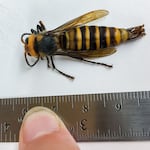Researchers say the invasive insects popularly referred to as “murder hornets” could expand into Oregon in ten years if not successfully contained in Washington.
The giant hornets, native to Asia, were discovered on Vancouver Island in Canada and the northwest part of Washington last year. They’re the world’s largest hornet — up to two inches long — and they prey on other insects.
Agriculture officials are highly concerned about the introduction and spread of Asian giant hornets because a few hornets can kill a honey bee hive in just a few hours.
The hornets are also known to pack a powerful sting.
A report published Tuesday in the Proceedings of the National Academy of Sciences looked at the habitat needs of the introduced hornets and mapped where and how quickly they are likely to spread if not controlled. The Washington State University researchers say the hornets need areas with moderate temperatures, high precipitation and high levels of human activity.

A male Asian giant hornet found in Washington.
WSDA
Oregon and Washington west of the Cascades are ideal and create a relatively continuous corridor of good habitat in which to expand. The report predicts it would take 20 years for the Asian giant hornets to make it to eastern Washington without intervention.
Intervention efforts are currently underway by the Washington State Department of Agriculture. The agency has set hundreds of hornet traps, focusing on the areas where they were discovered previously.
“We have our regular traps out, but we also have live traps, which would trap the Asian giant hornets but not kill it.” WSDA’s Karla Salp said. “We’re basically… in a little bit of a waiting game.”
The idea is to trap live hornets, tag and release them, and then track them back to their nest so the whole thing can be destroyed.
Related: The Search Is On For Every Bee Species In Oregon
So far, Washington officials have caught or found seven total giant hornets, all in Whatcom County, with the latest captured in mid-August.
In addition to the state-funded traps, Salp says citizen scientists and other partners have set nearly 1500 more across the state.
Similar trap-and-eradicate efforts have been successful in preventing the establishment of gypsy moths in Washington, but these hornets pose a bit more of a problem.
“We do not have a pheromone-specific lure that is specific only to Asian giant hornets or at least hornets. That makes it really tricky,” Salp said. “Right now our primary lure is orange juice and cooking rice wine, which attracts hornets, but it also attracts wasps, flies, it attracts moths.”
Salp says the U.S. Department of Agriculture is working to develop a better lure for the hornets.
Results of genetic testing published earlier this month suggested that the Asian giant hornets found in Canada and Washington are actually from different parts of the world – Japan versus Korea. Although there’s much uncertainty, this suggests the hornets might not have spread from one point of introduction. Instead, they could have made landfall in North America in two separate events.
It’s still unknown how the hornets arrived in the U.S. and Canada, but there’s a long history of non-native species unknowingly being transported via shipping cargo.
